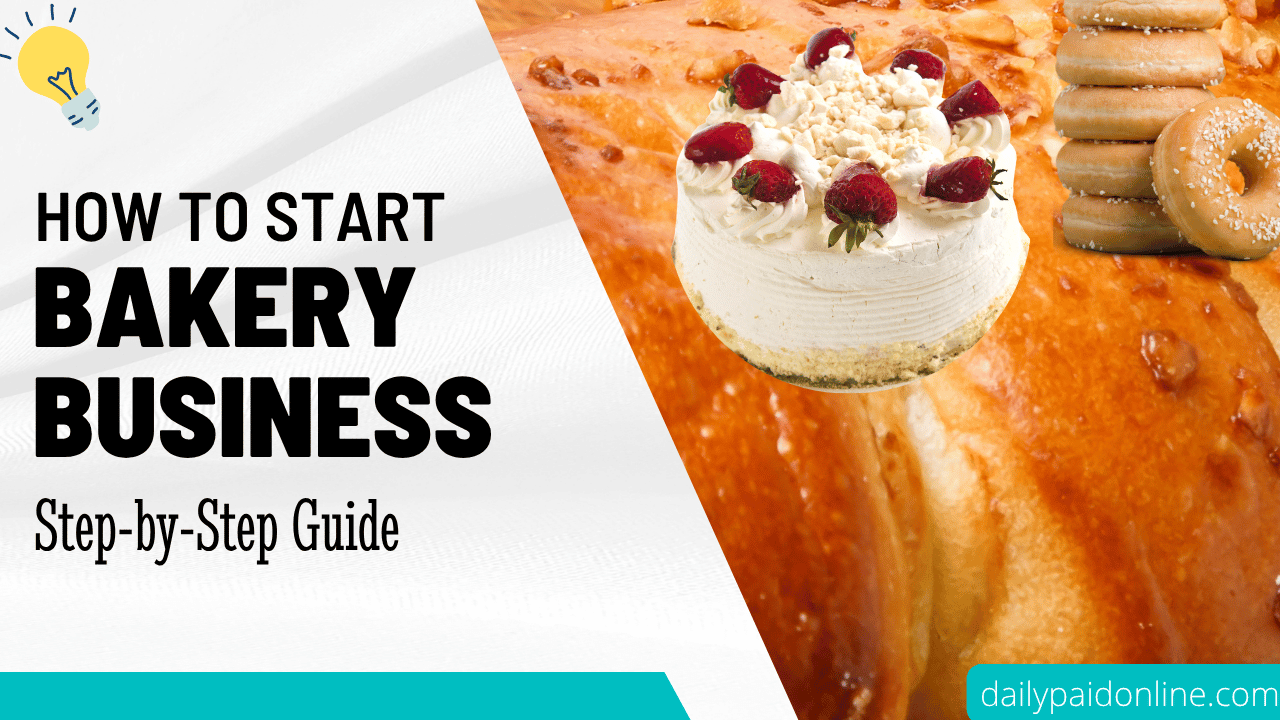The information provided in this blog post is for general informational and educational purposes only. It may contain affiliate links. If you make a purchase using one of these links, we may receive compensation at no extra cost to you. This will help us to maintain the website. Please read our disclosure policy for more information.
Disclaimer: This article is for informational purposes only and should not be considered as professional legal, financial, or business advice. Starting a bakery business involves various legal, financial, and regulatory requirements that may vary by location. Always consult with qualified professionals, including attorneys, accountants, and business advisors, before making any business decisions.
Starting a bakery business can be an incredibly rewarding venture for those passionate about baking and entrepreneurship. The aroma of fresh bread, the satisfaction of creating delicious pastries, and the joy of serving happy customers make bakery ownership an appealing career path. However, launching a successful bakery requires careful planning, dedication, and a solid understanding of both the culinary and business aspects of the industry. This comprehensive guide will walk you through each essential step to transform your baking passion into a thriving business.
Step 1: Develop Your Business Concept and Niche
Before diving into the practical aspects of starting a bakery, you need to define your unique business concept. The bakery industry offers numerous specialization opportunities, and identifying your niche will help you stand out in a competitive market.
Consider these bakery types:
- Retail bakeries that sell directly to customers
- Wholesale bakeries that supply restaurants and grocery stores
- Specialty bakeries focusing on specific items like wedding cakes or artisan bread
- Online bakeries operating primarily through e-commerce
- Mobile bakeries using food trucks or carts
- Gluten-free or vegan bakeries catering to dietary restrictions
Research your local market to identify gaps and opportunities. Visit existing bakeries, analyze their offerings, and determine how you can differentiate your business. Your unique selling proposition might be exceptional quality, innovative flavors, convenient location, competitive pricing, or specialized dietary options.
Step 2: Create a Comprehensive Business Plan
A well-crafted business plan serves as your roadmap to success and is essential for securing funding. Your bakery business plan should include:
Executive Summary: A brief overview of your bakery concept, target market, and financial projections.
Market Analysis: Detailed research on your local bakery market, including competitor analysis, target demographics, and industry trends.
Products and Services: Comprehensive list of your planned offerings, from bread and pastries to custom cakes and catering services.
Marketing Strategy: How you’ll attract and retain customers through branding, advertising, social media, and community engagement.
Operations Plan: Daily operations, supplier relationships, equipment needs, and staffing requirements.
Financial Projections: Startup costs, revenue forecasts, break-even analysis, and profit projections for at least three years.
Step 3: Secure Funding for Your Bakery
Starting a bakery typically requires significant upfront investment. Calculate your total startup costs, including:
- Commercial space lease or purchase
- Professional baking equipment and tools
- Initial inventory and supplies
- Renovation and decoration costs
- Marketing and branding expenses
- Working capital for the first few months
- Insurance and legal fees
- Point-of-sale systems and technology
Funding options include:
- Personal savings and investments from friends and family
- Small business loans from banks or credit unions
- SBA loans with favorable terms for small businesses
- Equipment financing specifically for bakery equipment
- Crowdfunding platforms for community support
- Angel investors or venture capital for scalable concepts
Step 4: Choose the Perfect Location
Location can make or break a bakery business. Consider these factors when selecting your bakery site:
Visibility and Accessibility: High foot traffic areas with easy parking or public transportation access typically perform better.
Demographics: Ensure your target customers live, work, or frequently visit the area.
Competition: Some nearby competition can indicate demand, but avoid oversaturated markets.
Space Requirements: Adequate space for production, retail display, storage, and potential seating area.
Zoning Regulations: Verify the location is properly zoned for food production and retail.
Future Growth: Consider whether the space can accommodate expansion as your business grows.
Step 5: Navigate Legal Requirements and Permits
Operating a bakery requires compliance with numerous regulations. Essential legal steps include:
Business Structure: Choose between sole proprietorship, partnership, LLC, or corporation based on liability protection and tax implications.
Business Registration: Register your bakery name and obtain necessary business licenses from local authorities.
Food Safety Permits: Acquire health department permits and ensure your facility meets all food safety standards.
Tax Registration: Obtain an Employer Identification Number (EIN) and register for state and local taxes.
Insurance Coverage: Secure general liability, property, workers’ compensation, and product liability insurance.
Building Permits: If renovating your space, obtain proper construction and signage permits.
Step 6: Design and Equip Your Bakery
Creating an efficient, attractive bakery space requires careful planning. Essential equipment includes:
Production Equipment:
- Commercial ovens (convection, deck, or rotating)
- Professional mixers of various sizes
- Proofers for optimal dough rising
- Refrigeration units and freezers
- Work tables and prep surfaces
- Baking pans, molds, and tools
Retail Equipment:
- Display cases for showcasing products
- Point-of-sale system with inventory tracking
- Coffee equipment is offering beverages
- Packaging supplies and equipment
- Customer seating (if applicable)
Design your layout to optimize workflow from production to customer service while maintaining an inviting atmosphere that reflects your brand identity.
Step 7: Develop Your Product Line and Pricing Strategy
Create a balanced menu that showcases your strengths while meeting customer demands. Start with a focused selection of high-quality items rather than trying to offer everything immediately.
Product Development Tips:
- Perfect your recipes through extensive testing
- Source high-quality ingredients from reliable suppliers
- Consider seasonal offerings to maintain customer interest
- Develop signature items that become customer favorites
- Account for dietary restrictions and preferences
Pricing Strategy:
- Calculate accurate food costs, including ingredients, labor, and overhead
- Research competitor pricing while considering your unique value
- Ensure prices provide adequate profit margins (typically 60-80% markup)
- Consider psychological pricing strategies
- Plan for wholesale pricing if applicable
Step 8: Build Your Team
Unless operating a very small operation, you’ll need skilled employees. Key positions include:
- Head Baker/Pastry Chef: Leads production and maintains quality standards
- Assistant Bakers: Support production during busy periods
- Front-of-House Staff: Provide excellent customer service
- Delivery Drivers: For wholesale or catering operations
- Administrative Support: Handle bookkeeping and ordering
Develop comprehensive training programs, create employee handbooks, and establish clear policies for food safety, customer service, and operations.
Step 9: Implement Marketing Strategies
Effective marketing is crucial for attracting customers and building loyalty. Comprehensive marketing approaches include:
Brand Development: Create a memorable logo, consistent color scheme, and compelling brand story that resonates with your target audience.
Digital Presence: Build a professional website with online ordering capabilities, maintain active social media profiles showcasing your products, and encourage customer reviews on platforms like Google and Yelp.
Community Engagement: Participate in local events, partner with nearby businesses, offer samples at farmers’ markets, and support community causes.
Grand Opening: Plan a memorable launch event with special promotions, free samples, and media coverage to generate initial buzz.
Step 10: Focus on Operations and Growth
Once open, concentrate on refining operations and building customer loyalty:
Quality Control: Maintain consistent product quality through standardized recipes, regular training, and customer feedback monitoring.
Inventory Management: Implement systems to minimize waste while ensuring product availability.
Customer Service: Train staff to provide exceptional experiences that encourage repeat business and positive word-of-mouth.
Financial Management: Track daily sales, monitor expenses, analyze profit margins, and adjust strategies based on performance data.
Expansion Opportunities: Consider growth through additional locations, wholesale accounts, catering services, or online sales.
Conclusion
Starting a bakery business requires significant planning, investment, and dedication, but the rewards of owning a successful bakery can be substantial. By following this comprehensive guide, conducting thorough research, and remaining committed to quality and customer satisfaction, you can build a thriving bakery that becomes a beloved part of your community. Remember that success rarely happens overnight – be patient, stay flexible, and continuously adapt based on customer feedback and market conditions. With passion, perseverance, and proper planning, your bakery dreams can become a profitable reality.

